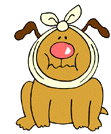|
 Leg bandages are typically applied for temporary stabilization of a fracture or to help reduce bleeding from a wound. Leg bandages are typically applied for temporary stabilization of a fracture or to help reduce bleeding from a wound.
You and your pet are far from help (perhaps camping or hiking), and your pet hurts himself. Would you know how to stabilize him until you could reach a veterinarian? This article provides some guidance in case of such an emergency, but it does not replace the skill and expertise of your veterinarian. If possible, it is better to let a trained expert treat your pet than yourself.
Head
The most common reason a head wrap is applied is to stop bleeding from the ears.
-
Use long strips of gauze or torn sections of sheet.
-
 Wrap completely around the head, pinning the ears to the side of the head. Wrap completely around the head, pinning the ears to the side of the head.
-
Be very careful not to wrap too tightly - you could cut off the airway.
-
Do not cover the animal’s eyes with the head bandage. This can increase fear and anxiety in the pet.
-
Once the bandage is in place, apply tape to the front edges of the bandage. Make sure that the hair is included in the tape. This will help keep the bandage in place and reduce the risk of slipping.
-
Once the bandage is in place, test the tightness: Try to place two fingers under the bandage. If you can do this, the bandage is not too tight.
After the bandage is applied, frequently check the animal for facial swelling or difficulty breathing. If either is detected, remove the bandage immediately.
Leg Bandage
Leg bandages are typically applied to help temporarily stabilize a fracture or to help reduce bleeding from a wound. |
|
-
If a wound is present, try to cover with a gauze pad or Telfa® pad.
-
Begin wrapping several layers of cotton (roll cotton) around the leg. If the bandage is being used to stabilize a fracture, the joint above and below the fracture must be included in the bandage. If the fracture is in the humerus or femur, bandaging is not helpful and can make the fracture worse.
-
 After several layers of cotton have been applied, next place several layers of stretch gauze over the roll cotton. This should be snug and compress the cotton. Having a snug bandage is crucial in stabilization and reducing pain. Be careful not too make the bandage so tight that circulation is disrupted. After several layers of cotton have been applied, next place several layers of stretch gauze over the roll cotton. This should be snug and compress the cotton. Having a snug bandage is crucial in stabilization and reducing pain. Be careful not too make the bandage so tight that circulation is disrupted.
-
Finish the bandage by applying an elastic bandage such as VetRap®, Ace® bandage or adhesive tape.
-
Secure the top of the bandage to the animal by applying one layer of sticky tape. Make sure the animal’s hair and the bandage are included in the tape. This will prevent the bandage from sliding off.
After the bandage is applied, frequently check the toes for swelling or coldness. If either is detected, remove the bandage.
Splint
Splints are used to add extra support to fractures of the bones below the elbow. Be very careful if you apply a splint to the rear leg. Due to the natural position of the rear legs, bandaging these bones in a straight alignment can be detrimental. Splints are best used only in the front legs.
-
Follow the instruction for leg bandage.
-
 After the cotton and stretch gauze have been applied, place a flat stick or straight piece of metal on either side of the leg and tape in place. After the cotton and stretch gauze have been applied, place a flat stick or straight piece of metal on either side of the leg and tape in place.
-
If no sticks or metal are available, rolled up newspaper or a magazine can be used. Place it next to the injured leg and tape in place.
-
Cover the bandage and splint with elastic bandage such as VetRap® or Ace® bandage.
-
Secure the top of the bandage to the animal by applying one layer of sticky tape. Make sure the dog’s hair and the bandage are included in the tape. This will prevent the bandage from sliding off.
Bandages and splints do not help fractures of the humerus (upper arm bone) or femur (thigh bone). They can even cause more damage. If you suspect that your pet has a fractured upper thigh bone or upper arm bone, do not use a bandage or splint. Try to keep your pet as quiet and confined as possible and contact your veterinarian.
By PetPlace Veterinarians
Web Site |